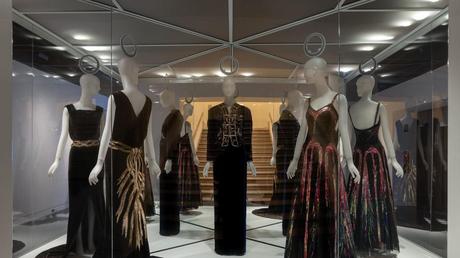
Last week, at a preview of the Costume Institute's new exhibit, Women Dressing Women, I heard women talking about the women who wore them. It was a fitting subject given the occasion, yet there was an excitement among fashion journalists and fashion fans alike that was missing; at least recently, after a string of white men received coveted creative director appointments, leaving many to wonder: where are the women?
Standing in front of a mannequin dressed in a Simone Rocha Spring 2023 dress, adorned with porcelain baby teeth and pearl-beaded chest pockets reminiscent of nursing bra cups, a friend excitedly pointed out the Simone Rocha dress at my body. According to the gallery's label, the one I admired was meant to refer to the "ghostly, deranged insomnia" of early motherhood.
The one I wore, with its easy-flowing frame, soft ruffles in the shape of an auspicious harness, and a zipper undone halfway up my spine, represented another facet of femininity. The one where your feet are tired from the daily dance of hurriedly trying to look good while still feeling beautiful enough to step out. I'm drawn to Rocha's clothes for exactly that reason: her frothy feminine creations are easy to put on and make me feel like Marie Antoinette (Sofia Coppola's version). When I asked my friend to help adjust the back zipper I couldn't make it all by myself that morning, and she agreed before adding, "Just women helping women!"
Melissa Huber, the associate curator of the Costume Institute, had not planned for this exhibition to take place at a time when women's bodies and those deemed worthy enough to dress them are under near-constant discussion. In fact, "Women Dressing Women" was originally planned for 2020, before pandemic lockdowns changed the museum's exhibition schedule.
And the idea itself first occurred to Huber many years ago while reading a photography book. "An author made a casual comment about the interwar period. It was something along the lines of, "Well, because this is the only moment in history where women are in the majority." And it was just so natural," she tells me via Zoom. "It really stopped me in my tracks." She noted that the period was filled with "so many important female designers who had a major impact on fashion history."
The story continues
She took the idea to the Costume Institute's chief curator, Andrew Bolton, who had also been toying with the idea of an exhibition celebrating female designers for some time. After Karen Van Godtsenhoven, a former associate curator at The Met, came to Bolton separately with a similar idea, he suggested that she and Huber collaborate on what would eventually open last weekend.
Considering that the more than 80 exhibits are part of the museum's permanent collection, it's strange to think that the idea hadn't arisen earlier. But even the former curator of the Costume Institute, Diana Vreeland, had to wait almost fourteen years before her retrospective exhibition Madame Grès finally took place in 1994. A white evening dress from that exhibition sits atop a column in front of the Costume Institute entrance, next to a moth-eaten sweater and skirt by Rei Kawakubo, the only other female designer to have a solo show at the Met.
However, celebrating female designers wasn't the only goal. "We came up with the idea of not only thinking about how important women have been to fashion, but also how important fashion has been to women," Huber notes.
And I think that concept is best expressed not in the four guiding concepts around which the show is built - anonymity, visibility, agency and absence/omission - but in the sub-themes that emerged as a result, such as 'Body Agency'. The designs in that section highlight how clothing "has served as a site of political and bodily expression" and include the Simone Rocha piece I mentioned earlier, because of the way Rocha incorporates the taboo ideas of reproduction into her design.
In addition, there was a section entitled 'Reclaiming the Body', which highlights the ways in which female designers subvert conventional gender expectations. It features a handful of pieces from Rei Kawakubo's 1997 "Bump" collection for Comme Des Garcons, where she famously said, "Body meets dress, dress meets body, and they become one."
Although often described as "alien appendages," the bumps protruding from her otherwise tight, form-fitting dresses and skirts were meant to mimic everyday objects-a child on an arm or a bag slung over the shoulder. Kawakubo redefined the female silhouette as something that served less as an object of desire and more as a reflection of life itself.
As for Huber's favorite parts of the exhibition, she mentions the slideshow of images projected alongside the text on the gallery wall for the "Anonymity" section. "I like looking at these images of women and their expressions. I feel like their personality shines through these images," she says.
It actually brought back a memory of Lagerfeld's show last spring, in which she supported Bolton. "We had the great pleasure of bringing many of these women to the exhibition and seeing their reactions to the garments they worked on. And their pride in their work and the way they interacted with each other and how incredibly dedicated and connected they were to it was such a beautiful thing to experience and something that I really love about fashion. This idea that the collective nature of design is something that we really hope our visitors will take into account."
Looking around at the preview, where women complimented each other's outfits or pointed to each other's favorite designers, it became clear that Huber's hopes had already been set in motion. If only, as I heard a handful of guests say, some big houses with an open creative director role would take notice.
"Women Dressing Women" runs through March 3 at the Metropolitan Museum of Art, 1000 Fifth Ave. You might also like it